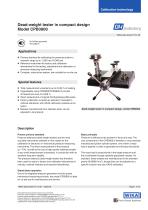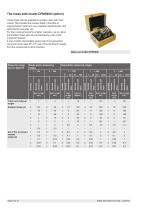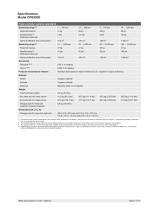
Catalog excerpts

Calibration technology Dead-weight tester in compact design Model CPB3800 WIKA data sheet CT 31.06 for further approvals see page 9 Applications ■■ Primary standard for calibrating the pressure scale in a ■■ Reference instrument for factory and calibration laboratories for the testing, adjustment and calibration of pressure measuring instruments ■■ Complete, stand-alone system, also suitable for on-site use Special features ■■ Total measurement uncertainty up to 0.025 % of reading ■■ Upgradeable using CPS5800/CPM5800 to provide ■■ Direct replacement of original DH-Budenberg 580 series ■■ Factory calibration included as standard, traceable to national standards, with UKAS calibration possible as an option ■■ Masses manufactured from stainless steel, can be adjusted to local gravity Dead-weight tester in compact design, model CPB3800 Description Proven primary standard Pressure balances (dead-weight testers) are the most accurate instruments available on the market for the calibration of electronic or mechanical pressure measuring instruments. The direct measurement of the pressure (p = F/A), as well as the use of high-quality materials enable a very small measurement uncertainty, in conjunction with an excellent long-term stability. The pressure balance (dead-weight tester) has therefore been used for years in factory and calibration laboratories in industry, national institutes and research laboratories. Basic principle Pressure is defined as the quotient of force and area. The core component of the CPB3800 is therefore a very precisely manufactured piston-cylinder system, onto which a mass load is applied in order to generate the individual test points. The mass load is proportional to the target pressure and this is achieved through optimally graduated masses. As standard, these masses are manufactured to the standard gravity (9.80665 m/s²), though they can be adjusted to a specific location and also UKAS calibrated. Stand-alone operation Due to its integrated pressure generation and the purely mechanical measuring principle, the model CPB3800 is ideal for on-site use for maintenance and service. WIKA data sheet CT 31.06 ∙ 03/2016 Data sheets showing similar products and accessories: Pneumatic pressure balance; model CPB5000; see data sheet CT 31.01 Hydraulic pressure balance; model CPB5800; see data sheet CT 31.11 Pressure balance for high pressure; model CPB5000HP; see data sheet CT 31.51 Pressure balance for differential pressure; model CPB5600DP; see data sheet CT 31.56 CalibratorUnit; model CPU6000; see d
Open the catalog to page 1
Control schematic on the CPB3800 instrument base Easy operation The integrated dual-area spindle enables rapid filling of the test system and smooth pressure generation to up to 1,200 bar (16,000 psi). At the same time, the precisely adjustable spindle pump enables fine pressure adjustment. A control schematic for pressure generation on the instrument base facilitates quick and easy operation. As soon as the measuring system reaches equilibrium, there is a balance of forces between the pressure and the masses. The excellent quality of the system ensures that this pressure remains stable...
Open the catalog to page 2
The standard piston-cylinder system Both the piston and cylinder are manufactured from tungsten carbide. This pairing of materials, in comparison to other materials, has very low pressure and temperature coefficients of expansion, which results in a very good linearity for the effective area of the piston and a very high accuracy. Piston and cylinder are very well protected against contact, impacts or contamination from outside in a solid stainlesssteel case. At the same time, overpressure protection is integrated, which prevents the piston from being forced out vertically and avoids damage...
Open the catalog to page 3
The optional piston-cylinder system model CPS5800 The CPS5800 piston-cylinder systems are available in two fundamentally different designs, depending on the measuring range: ■■ Single-range piston-cylinder system for measuring ranges ■■ Dual-range piston-cylinder system for measuring ranges High accuracy over a wide measuring range The dual-range piston-cylinder system offers two measuring ranges in one case with automatic measuring range switching from low-pressure to high-pressure piston. This provides the user with an extremely flexible measuring instrument that can cover a wide...
Open the catalog to page 4
The following tables show the number of masses within a mass set with their nominal mass values and the resulting nominal pressures for the respective measuring ranges. Should the instrument not be operated under reference conditions (ambient temperature 20 °C (68 °F), atmospheric pressure 1,013 mbar (14.69 psi), relative humidity 40 %), the relevant corrections must be made, for example with the CPU6000 CalibratorUnit, see page 13. The masses are manufactured, as standard, to the standard gravity (9.80665 m/s2) although they can be adjusted for any local gravity. Standard mass sets...
Open the catalog to page 5
These mass sets are supplied in wooden cases with foam inserts. This includes the masses listed in the table of masses below, made from non-magnetic stainless steel, and optimised for everyday use. For finer increments and for a higher resolution, as an option, the standard mass sets can be extended by a set of fine increment masses. If even smaller intermediate values need to be generated, using one of the class M1 or F1 set of fine increment masses from the accessories is recommended. Single-piston measuring ranges Dual-piston measuring ranges Piston and make-up weight Standard mass set...
Open the catalog to page 6
1) Theoretical starting value; corresponds to the pressure value generated by the piston or the piston and its make-up weight (by their own weight). To optimise the operating characteristics more masses should be loaded. 2) The smallest pressure change value that can be achieved based on the standard mass set. To reduce this, a set of fine increment masses is also available. 3) The accuracy from 10 % of the measuring range is based on the measured value. In the lower range, a fixed error based on 10 % of the range applies. 4) Measurement uncertainty assuming reference conditions (ambient...
Open the catalog to page 7All Mensor catalogs and technical brochures
-
Mensor Sensors
2 Pages
-
WIKA Handbook
436 Pages
-
Calibration
20 Pages
-
Handbook Calibration
73 Pages
-
Condensed Custom Systems
4 Pages
-
Custom Systems
20 Pages
-
Calibration Technology
32 Pages
-
Model CPB5000
12 Pages
-
Model CPB3800hp
9 Pages
-
Model CPB3500
9 Pages
-
Model CTP5000
6 Pages
-
Models CTP2000, CTP9000
4 Pages
-
Model WIKA-Cal
6 Pages
-
Model CPA8001
8 Pages
-
Model CPC8000-H
7 Pages
-
Model CPC8000
8 Pages
-
MODEL CPC7000
9 Pages
-
Model CPC6050
8 Pages
-
Model CPC4000
8 Pages
-
Model CPC2000
6 Pages
-
Model CPG500
6 Pages
-
Model CPG-KITH
6 Pages
-
Model CPG-KITP
6 Pages
-
Model CPG1500
11 Pages
-
CPG2300
2 Pages
-
CPG2400 Barometer
2 Pages
-
CPA8001
8 Pages
-
CPA2501
8 Pages
-
CPC8000
8 Pages

































